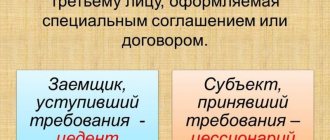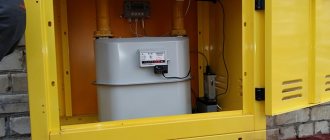No. 1. Criteria for choosing the type of fencing
Fencing is assigned a number of tasks , among which the main ones are :
- defining boundaries;
- ensuring the security of the territory;
- site decoration.
Each fence, to one degree or another, performs these functions, but since the dacha plot borders on different objects, some fences will perform these tasks to a greater or lesser extent. For example, a fence that separates a site from a street , road or forest must, first of all, be reliable and provide protection, while a fence separating your site from your neighbor’s serves mainly to define the border and decorate the territory - it is solid and impregnable doesn't have to be. In any case, the fence should be aesthetically pleasing and not spoil (or rather decorate) the suburban area.
The most important factor when choosing a fence material is the style of landscape design. For areas made in a classic style, the best decoration will be stone, brick or wrought iron fences, a country style will be decorated with a wooden fence, and in a folk style a wicker fence will be appropriate. It’s great if the fence, house and other buildings on the territory have some common features.
Classification
Fences are distinguished depending on the purpose, or more accurately, the characteristics of the object. Obviously, the requirements for a fence around an airfield and a playground are completely different.
On the territory of dacha associations, plot owners are faced with two types of fences:
- external – separating the site from the road or passage;
- between neighbors - that is, located on the boundaries between two neighboring plots.
SNiP for fence installation clearly regulates their parameters. Violation of the requirements is fraught with administrative liability, a fine, or even dismantling of the fence without compensation for material losses.
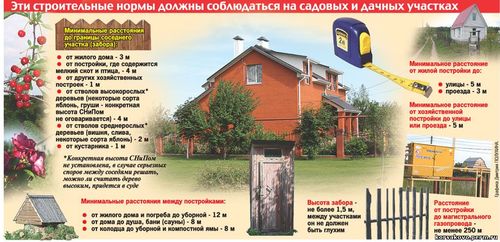
No. 2. Regulatory requirements for site fencing
To avoid unnecessary hassle, it is necessary to obtain permission for its construction even before the construction of the fence begins. If the project is completed in compliance with all the standards for country fencing, no problems will arise. According to regulatory documents, the fence separating two neighboring plots should be no higher than 1.5 m and not obscure the adjacent territory. Therefore, it must be made from mesh or lattice materials. The height of the fence facing the street can reach 2 m . Such fences can be made of any materials; there are no requirements for transparency.

The rules also regulate the distance of the fence from objects on the site : 3 m for houses and 4 m for enclosures for pets. Before you put up a fence between your property and your neighbor’s, you need to mark it and then agree on the border with your neighbors. This will not only maintain normal relations, but also avoid future disputes over illegally seized land.

Building codes for external fencing
SNiP are considered as a recommendation that must be taken into account during construction. This does not mean that its requirements are optional, but the ability of local administrations to develop their own standards based on generally accepted ones.
- According to SNiP, the height of the fence on the side of the street, driveway or square reaches 2.2 m. A large value is undesirable, as it will serve as an obstacle to normal evening street lighting.
- The external fencing can be solid - made of corrugated board, brick, concrete, and so on. The photo shows a sample.
- The design must comply with safety regulations and not pose a threat to passersby. For example, a lattice option with peaks in the form of peaks is allowed if the sharp peaks are directed strictly vertical. If the peaks are directed towards the sidewalk, this is a violation. For the same reasons, barbed wire or untreated wood surfaces at human height are not allowed.
- Installing a fence involves draining rain and storm water. To do this, the strip foundation involves laying drainage pipes or arches. When using a non-continuous foundation, such problems do not arise.
- If an entrance is provided from the street side - a wicket door, a gate, then if the distance to the sidewalk is less than 1.5 m, the gate should open inward so as not to interfere with pedestrians.
The local administration has the right to regulate the color and material of the fence, so before its construction it is necessary to coordinate your actions with the board.
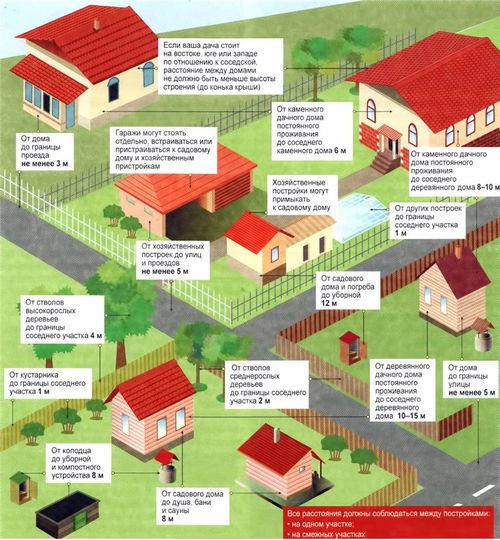
No. 3. Type of foundation for a country fence
Since the fence is assigned protective functions, it must be reliable, strong and durable, which is impossible without an appropriate foundation. For collection, use one of the following options:
- tape the foundation is built if the fence cladding is heavy. It requires digging a ditch at least 30 cm deep, which is filled with a layer of crushed stone or gravel, then a reinforcement frame and formwork are installed, its height should be 20-30 cm above ground level. Then the formwork is filled with concrete;

- pillar foundation suitable for fences consisting of separate spans (chain-link mesh, corrugated sheeting, etc.). The distance between the pillars depends on the length of the spans. For each pillar, a hole is made about 1 m deep; after installing the pillar, the pit is filled with cement-sand mortar.
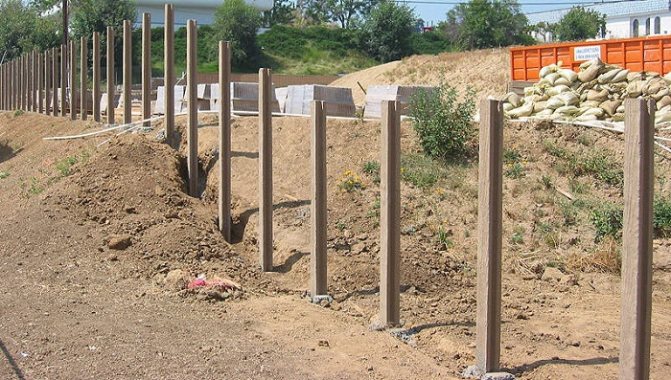
SanPiN rules
Sanitary standards are no less demanding regarding distances between objects. According to SNiP, the construction of fences is impossible without their implementation:
- between outbuildings - a barn, a garage, and a fence, the distance must be at least 1 m;
- the same distance is maintained between the fence and low trees and bushes of 1 m. Medium-sized trees can be planted at a distance of 2 m, tall ones - from 4 m;
- a toilet, cesspool, outbuildings containing birds or animals must be located at least 12 m away from the boundaries of the site.
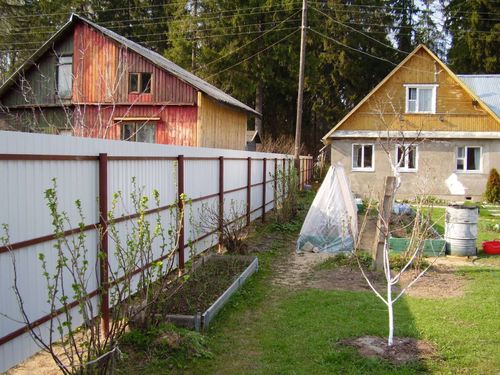
No. 4. Main types of materials for fencing construction
There are many options for making a garden fence. Fence cladding is made from the following types of materials:
- metal _ This group includes both forged and welded structures, as well as chain-link mesh, as well as corrugated fences;
- wood , including clapboard, board and picket fence;
- brick , stone and concrete;
- plastic and polycarbonate ;
- original solutions , such as hedges, wicker fences, etc.
Each of the listed options requires detailed consideration.
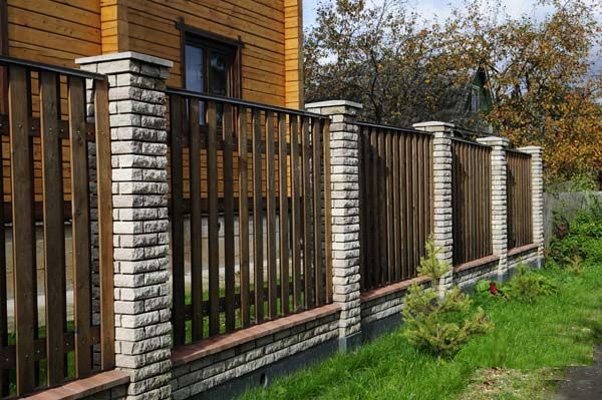
No. 5. mesh fence
Fences made of chain-link mesh , corrugated and welded mesh are one of the most popular methods of fencing domestic summer cottages. It is not difficult to install such a fence yourself; the thickness of the wire must be at least 1.8 mm so that it does not lend itself to wire cutters.
Main advantages:
- low cost;
- high durability, reaching 30 years. Galvanized mesh and polymer-coated mesh perform best in this regard;
- resistance to any vagaries of nature;
- excellent light transmission. The mesh fence will not shade the beds and will allow you to make the most efficient use of the entire area of the site;
- good protection. Despite its fragility and transparency, the mesh is not easy to overcome. It will sway under the weight of the attacker, and its upper part can cause injury;
- ease of installation and maintenance;
- high maintainability. If the mesh becomes damaged or sagging, it can be replaced or tightened.
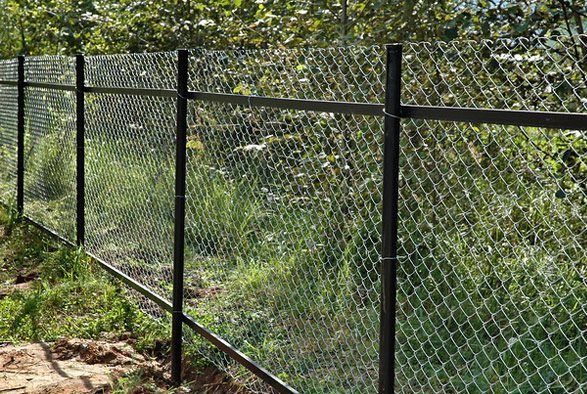
Moreover, the mesh can serve as an excellent basis for climbing plants, incl. ivy and hops.
Flaws:
- not the most aesthetic appearance;
- the mesh will not block the area from the views of strangers - this is the other side of excellent light transmission.
Mesh fencing is great for separating your territory from your neighbor's. In small areas it can also be used as the main fence.

Building codes for fences between adjacent plots
The requirements for the arrangement of internal fences are dictated by two considerations. Firstly, it should not obscure the neighboring area. Secondly, it should not interfere with the drainage of groundwater or storm water.
- SNiP allows only a transparent fence between neighbors - mesh or lattice. It is not a violation to cover the lattice frame with polycarbonate or other translucent material, as in the proposed photo.
- The height of the fence can reach 1.5 m. If we are talking about a blind version, then the size of the latter cannot be more than 0.75 m - the neighbor’s consent is not required. The administration has the right to change these requirements. Thus, the size of the fence between neighbors in some areas reaches 2.2 m.
- The thickness of the fence is not regulated. But if it exceeds 5 cm, then it is installed within the boundaries of the owner’s property.
- If the construction of a fence is carried out unilaterally, then the logs are placed on the inside. Decorative decorations are vertical or tilted towards their site.
- It is allowed, but only with the consent of neighbors, to organize a hedge of bushes no more than 1.5 m high.
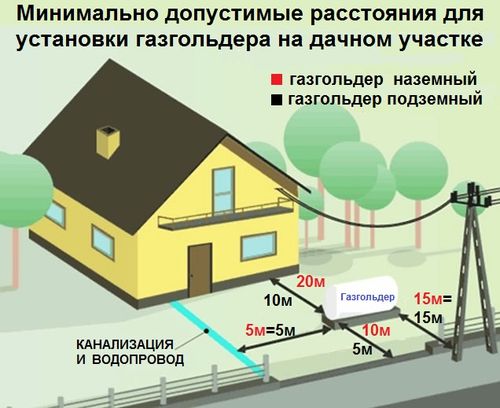
A blind fence can be constructed between adjacent plots only with the written consent of both parties. Documented consent is required, since violation of SNiP norms is grounds for administrative liability.
No. 6. Wrought iron fence
A wrought iron fence is luxury and excellent appearance along with excellent performance. This type of fencing is suitable for areas designed in a classic style ; it is always made to order and installed by professionals.
Main advantages:
- record durability reaching 50 years or more;
- resistance to sunlight and winds;
- excellent decorative qualities;
- reliability and strength. Such a fence will be difficult to damage, and if there are elements on top in the form of sharp pins, then not everyone will risk or be able to climb over such a fence;
- good ventilation and light transmission;
- minimal care.
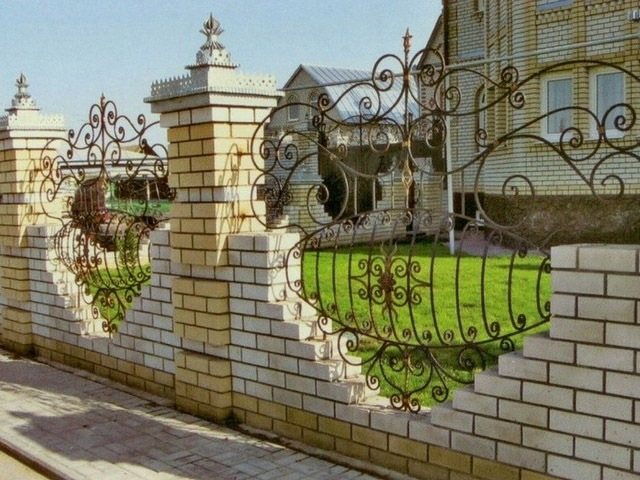
Flaws:
- high price;
- heavy weight of the sections, which complicates the transportation and installation process;
- metal can rust over time, so sometimes you will have to treat the surface with special substances, but this is not so troublesome;
- transparency of the forged fence.
Wrought iron fences are usually installed at the border of the site and the street, and since they do not hide everything that happens on the territory, they are recommended to be used when the site is quite large or located in a very quiet and impenetrable place. Often forged sections are combined with stone, brick or concrete .
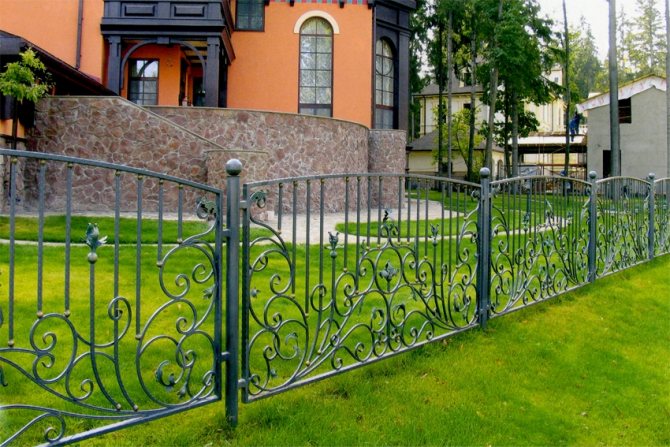
On paper
Methodological recommendations for the appearance of all kinds of fences were approved in the region back in 2014.
At the same time, the Moscow Regional Duma adopted a law on improvement, which obligated owners to maintain their fences in proper order. Namely, wash it when it gets dirty and repair it if necessary, but at least once every three years. The reason for issuing orders is considered to be dirty and peeling fences, as well as “drunk” fences that deviate from the vertical, and fences that have been destroyed by 20 percent or more. Fences higher than two meters are also prohibited in the region. In exceptional cases, when households are located along busy highways or railways, whose round-the-clock noise can poison any sleep and rest, fences are allowed to be raised up to three meters, but only in agreement with the local authorities. Fences in the form of continuous brickwork or sheets of metal without alternating with vertical posts or supports are prohibited. This is a kind of safety technique: if the ground under the fence is flooded in one place, the solid fence array will fall along the entire perimeter of the site. Wooden or chain-link fences are allowed, but are welcome only in SNT or on secondary streets of populated areas. And around buildings facing central streets or highways, you need to install fences made in the same style so that they are in harmony with each other in color, shape and height.
You cannot build fences from scrap materials, such as the backs of old beds and other remnants of furniture. And in urban areas, you can’t even paint fences black.
No. 7. Profile pipe fence and welded fence
These types of fencing are an alternative to a wrought iron fence . They cost much less, are not inferior in basic performance qualities, but look a little simpler. To make a fence from a profile pipe, round or square pipes are used. Sections of such a fence are 2-3 times cheaper than their forged counterpart, durable, strong, do not require special care, and have good aesthetic qualities.
For the manufacture of welded fences, not only pipes are used, but also rods and strips. The production process is quite simple, and there are many design options. While maintaining all the advantages of a wrought iron fence, such fences cost 5 times less. Can be combined with brick, stone and concrete pillars.

No. 8. Corrugated fence
Country fences are increasingly made from corrugated sheets. These are sheets of steel with a protective zinc or polymer coating , and they can imitate wood or stone. Corrugated sheeting can be used to separate a site from the street, as well as to construct temporary fences for the period while work on the construction of a house and other buildings is underway on the territory.
Advantages:
- durability (up to 45 years), resistance to winds, sunlight, precipitation and other negative environmental factors;
- durability and excellent protective functions;
- affordable price and wide range;
- the ability to block some external noise, so such a fence can be used for areas located near roads;
- ease of use, because the sheets are not very heavy and are easy to cut;
- easy maintenance and high maintainability (damaged sheets can be replaced).

Flaws:
- low aesthetics, especially from the inside;
- the material does not provide ventilation.
Often corrugated sheets are combined with concrete or brick.

Do I need to coordinate the fence with my neighbors?
To install a fence made of corrugated sheets or to avoid dismantling an already built fence, you must obtain the voluntary written consent of the owner of the neighboring plot. This way you will be legally protected even if your neighbors change their minds over time for some reason.
At the same time, there are no restrictions on what materials the fence along the facade of the site will be built from. You can block a country house from a street or a busy road with a high fence made of any material, including polycarbonate, metal profile, wood or metal sheet. However, it should be noted that restrictions on the maximum height of the fence may be set by the local administration board.
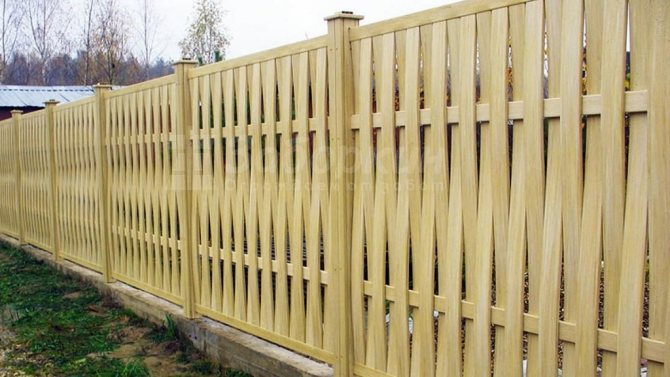
No. 9. Euro picket fence
Euro picket fence is something between a wooden picket fence and corrugated board. It is made of galvanized steel , which is additionally coated with a protective and decorative polymer layer. Externally, the Euro picket fence is very similar to wood , but at the same time retains all the main advantages of corrugated board.
The material available for sale may vary significantly in the way edges are processed, the type of profile and the method of painting. Sold in strips up to 10 cm wide and 1.5 to 3 m long, they provide ventilation of the area and allow sunlight to pass through. However, a piece picket fence does not provide adequate strength to the fence.


Fire safety rules
SNiP does not regulate the distance to the fence from the street, since the width of the road is not its object. However, fire safety rules include the following requirements:
- the distance between residential buildings made of non-combustible materials - brick, concrete - is 6 m;
- between wooden structures – 15 m;
- the distance between structures that include both hot and non-combustible materials is at least 8 m. However, the distance between objects within the site is not regulated.
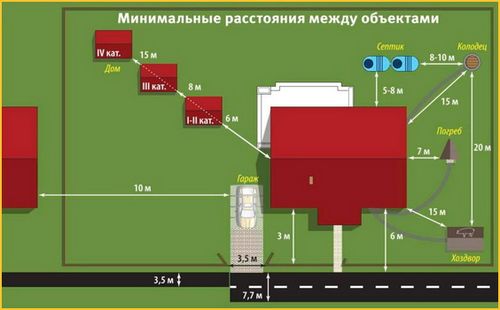
No. 10. Wooden fence
Wooden fencing is a timeless classic. Such a fence can be easily made and installed with your own hands, and due to the ease of wood processing, almost any idea can be turned into reality. The easiest option is to buy ready-made sections of wooden fencing , the choice of which is, without exaggeration, huge. “Store” products, as a rule, are sections of wooden picket fence of any height and width, fastened with horizontal strips. The design can be anything.
You can make your own wooden fence from sanded or unedged boards , beams or even lining. The boards can be fastened at a certain distance from each other or without gaps. The tree can be given any shape and painted in the desired color or varnished , creating a fence that best matches the style of the site.
Main advantages:
- high aesthetics and variability of solutions;
- low cost of ready-made fences and ease of creation with your own hands;
- naturalness and environmental friendliness;
- ease of installation;
- the ability to ventilate the area and transmit light (for certain types of construction).
Flaws:
- low durability, susceptible to rotting. A wooden fence is unlikely to last more than 15 years, and then only with constant maintenance;
- the need for regular maintenance, which consists of treating with an antiseptic, touching up the paint, replacing boards;
- low level of protection;
- fear of fire.
A low-height wooden fence can serve to separate neighboring areas, as well as to fence off separate areas of the territory, flower beds, etc. An external wooden fence should have a decent height, and combining it with concrete or stone will provide the area with better protection.
Requirements for protective fences GOST
Before you begin design, you need to determine the nature of the production equipment and the safety requirements that apply to them. The legislation establishes standards for fencing and general recommendations are specified in GOST 12.2.062-81 “SSBT. Production equipment. Protective fences." This standard applies to safety guards for production equipment designed to protect workers from the hazards created by moving parts of production equipment, products, workpieces and materials, flying particles of work material and splashes of cutting fluids, and establishes safety requirements for the design, use and size of the guard. depending on the location of dangerous elements.
Read “GOST 12.2.062-81 Production equipment. Protective fences."
The safety of the fence is ensured by two main factors - the quality of the fence and the reliability of the installation. What are the requirements for product characteristics in accordance with GOST? This is discussed in paragraphs 4, 6, 7, 9, 10 and 17.
- clause 4 The fence should not be a source of danger.
- clause 6 It is preferable to use continuous fences. Fences made from mesh must be designed to ensure consistency of shape and specified rigidity.
- clause 7 The design of the fence must correspond to the functional purpose and design of the equipment on which it will be installed, in accordance with the requirements of GOST 12.2.003-91 and GOST 12.2.061-81, as well as the conditions in which the equipment will be operated.
- clause 9 The strength of the fence must be established taking into account the load determined by the forces exerted on the fence by operating, collapsing parts of equipment or emissions.
- clause 10 The protective function of the fence should not be reduced under the influence of production factors (for example, vibration, temperature, etc.) individual development for each equipment.
- clause 17 A fence that is periodically opened manually must be painted on the inside in a signal color in accordance with GOST 12.4.026-76.
The parameters of the protective fence are calculated individually for each equipment or technological chain and are based on the Inter-industry rules on labor protection for work performed, which must specify the requirements for the general organization of work and for specific activities.
Recommendations
There are several most common rules and recommendations that must be followed when creating protective fences at production sites.
- All mechanisms must have a strong metal fence - solid, mesh, railings, reliably blocking access from all sides to moving parts.
- Fences installed at a distance of more than 35 cm from the moving parts of the mechanism can be made in the form of railings . If it is installed at a distance of less than 35 cm, it must be solid or mesh in a metal frame .
- The height is determined by the dimensions of the moving parts of the mechanism, but must be at least 1.25 cm . The height of the lower belt of the fence should be 15 cm (side board), the gap between individual belts should be no more than 40 cm, and the distance between the axes of adjacent risers should not be more than 2.5 meters. The height of the mesh fence must be at least 1.8 meters . Mechanisms with a height of less than 1.8 m must be completely enclosed .
- Railings for drive belts must be at least 1.5 m . Metal end shields must be installed on the outside of both pulleys in case the belt breaks.
- Gear and chain drives must be protected by solid metal shields .
- The fence must be painted on the inside in a signal color . This is regulated by GOST 12.4.026-76 “SSBT. Signal colors and safety signs.” Read the document.
We also recommend that you familiarize yourself with such a document as “ Typical documentation for mesh fencing of electrical equipment Series 5.407-131 ,” which was developed by the CITP of the USSR State Construction Committee, but modern design developments are still based on it.
Read “Standard documentation for mesh fencing of electrical equipment Series 5.407-131.”
No. 11. Concrete fence, or eurofence
A concrete fence can turn a site into an impregnable fortress. Gray boring solid reinforced concrete slabs, although they continue to be used, are inferior in popularity to prefabricated concrete eurofences . The latter are concrete pillars and panels, which are made using standard technology, but decorative forms are used when pouring. Thanks to painting, the eurofence gets a good appearance and can easily pass for stone or brick . It can be either blind, open or partially open. Ordinary reinforced concrete slabs cannot boast of such decorative qualities.
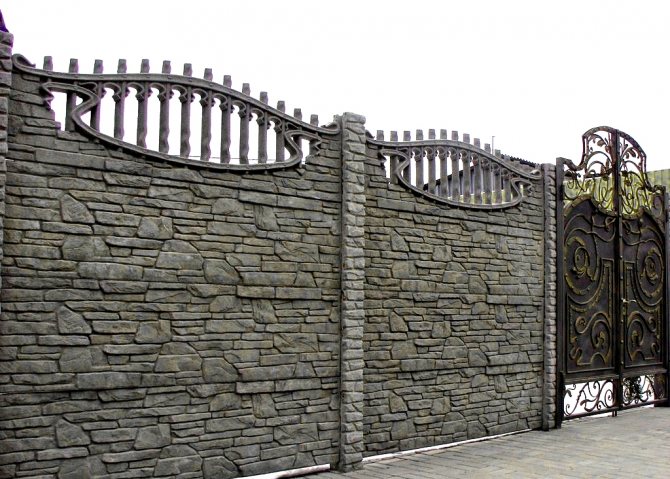
Advantages:
- high strength and durability, can last up to 100 years;
- the widest range of eurofences, which can imitate brick, slate, rubble stone, wood and even have openwork elements;
- excellent protective functions;
- resistance to all negative environmental factors and fire;
- ease of care.
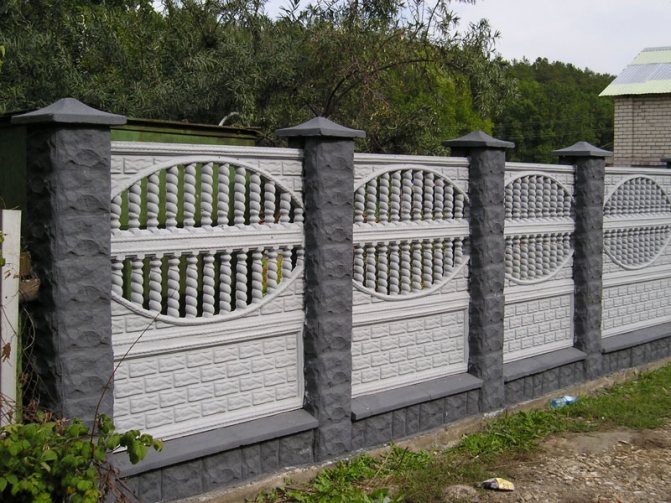
Flaws:
- heavy weight, which greatly complicates transportation and installation - you can’t do it with your own efforts;
- high price (especially for eurofence), since there are high costs for delivery and installation.
Despite the existing shortcomings, a concrete fence is one of the best options for fencing an area , as it will provide it with reliable protection for a long time, without requiring constant maintenance.
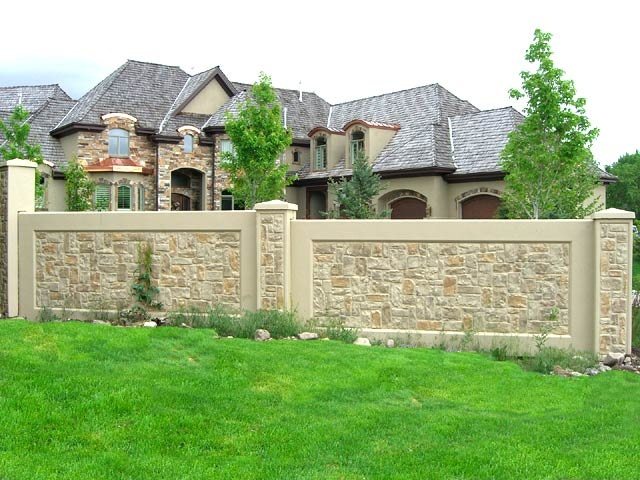
No. 12. Fence made of brick or stone
The similar properties of brick and stone make it possible to combine them into one section. At the same time, it should be noted that despite the naturalness and higher durability of the stone, it is used quite rarely due to its high cost. Building even a small fence from natural stone is a pleasure that not everyone can afford. A brick fence will cost less, but will look no worse. Either stone or brick fencing is a capital structure that requires design, but such a fence can become the face of the entire site.
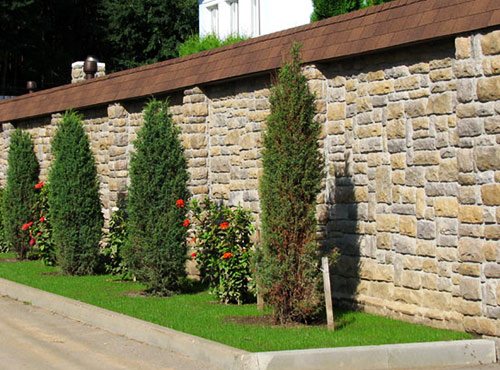
Advantages:
- durability (50 years for brick and higher for stone);
- strength, reliability and high level of protection;
- resistance to weather vagaries;
- environmental friendliness;
- excellent sound insulation qualities;
- fire resistance;
- ease of care;
- wide design possibilities. You can choose any color of the material, choose the desired masonry pattern, combine brick or stone with metal or wood.
Flaws:
- high price;
- complexity of installation.
Along with the fact that a brick fence protects from strong winds, it completely deprives the area of ventilation and creates a large shadow. The exception is the combination of brick and metal.
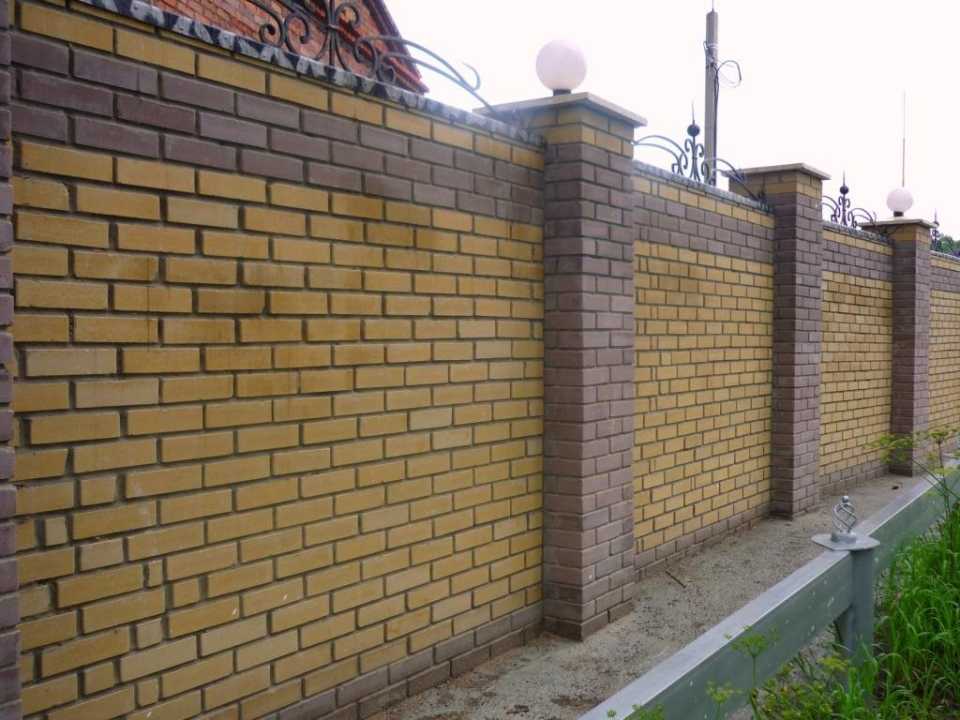
No. 13. Polycarbonate fence
Polycarbonate is traditionally used for arranging canopies and canopies, and is often used in the construction of greenhouses. Available in the form of light, large, slightly bendable translucent sheets of different shades. Polycarbonate sheets are mounted on a metal frame, and when combined with other materials, good results can be achieved in terms of aesthetics.
Advantages:
- a light weight;
- flexibility, allowing you to experiment with the shape of the fence;
- translucency. Polycarbonate allows up to 90% of sunlight to pass through, but does not allow strangers to see what is happening on the site;
- good soundproofing qualities, which is explained by the presence of air inside the cells;
- resistance to high and low temperatures, direct sunlight and moisture. Polycarbonate is not subject to corrosion or rotting, and mold will not develop on it;
- simple care, which consists of periodically washing the material using a regular garden hose;
- aesthetic appearance.
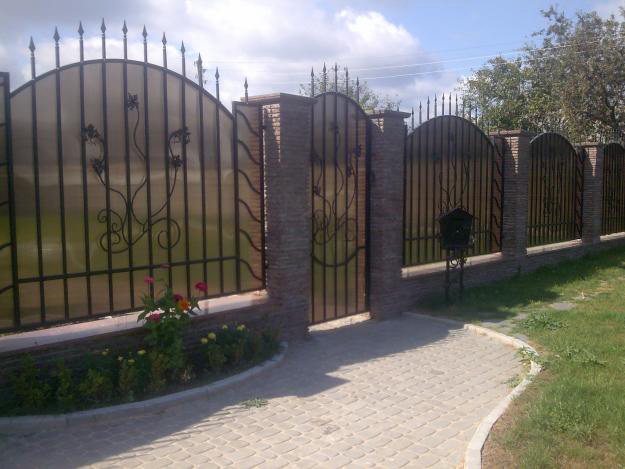
Flaws:
- not the lowest price;
- the need to construct a solid metal frame so that the sheets do not “sink” from wind and mechanical loads;
- low strength. Over time, scratches will appear on the polycarbonate, and hitting or throwing stones at it is not recommended. By combining the material with brick and forged gratings, this disadvantage can be significantly minimized.
No. 14. PVC fence
Plastic fences, long popular in Western countries, have recently begun to conquer the domestic market. They are highly decorative and can imitate a lot of natural materials , but their choice is not so wide yet. A plastic fence can be used for zoning a site, fencing flower beds, and a children's play area. It can be used as the main fence only when one requirement is put forward for the fence - to show the boundaries of the site, and not to serve as protection from intruders and prying eyes.
Advantages:
- excellent appearance;
- low weight, easy installation and maintenance;
- high durability (up to 50 years);
- resistance to sunlight, low temperatures and moisture.

Flaws:
- low strength and vulnerability to mechanical damage;
- low resistance to wind loads;
- high price.
No. 15. Wicker fence
If the garden plot is made in a rustic style, then its best decoration will be a wicker fence. It is not difficult to make it with your own hands, but for this you will have to stock up on branches of willow, hazel or other flexible plants. The height of the fence can be either minimal (for flower beds and zoning the site), or medium (for separating the territory from the neighboring one) or even large (for fencing the site around the perimeter).
Advantages:
- excellent appearance, environmental friendliness and naturalness;
- minimum cost if you make the fence yourself. Ordering a ready-made wicker fence will also be inexpensive;
- the opportunity to experiment with the type of weaving and the height of the fence.
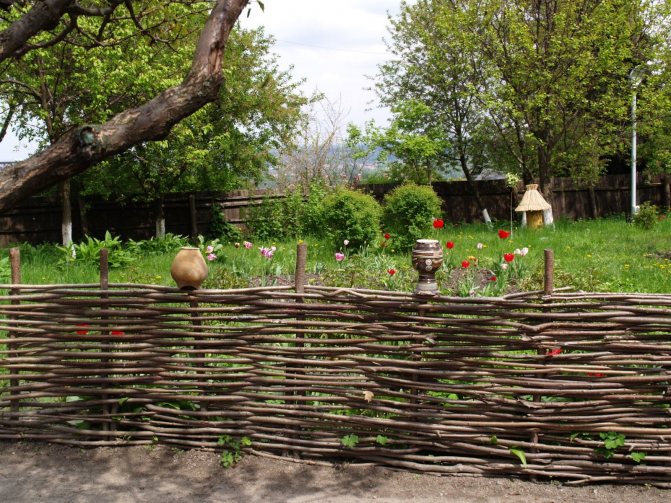
Flaws:
- low strength. A wicker fence mostly performs decorative functions, so there are no expectations placed on it for high reliability;
- low durability;
- the need for minimal skills and patience to create a wicker fence with your own hands.
Responsibility for violations
The owner of a dacha plot must survey the site and only after that plan the construction of the fence, its height and configuration. The installation of a blind fence between neighboring dachas is regarded as preventing the owner from using the land that belongs to him. In other words, if you violated the rules for installing a fence between neighbors, then you deprived the owner of the neighboring plot of the opportunity to grow crops. A blind fence creates continuous shadow, blocks the beds from sunlight, and interferes with the free circulation of air, which has a detrimental effect on plants. For installing a solid fence between your dachas, your neighbor may file a claim against you, which will be considered in court. According to the legislation of the Russian Federation, violation of the rights of the owner may entail punishment - a fine, which is not a fence.
Changes in regulatory documentation introduced in 2021 establish certain requirements for the materials used to make fences. A continuous fence between plots in SNT is not allowed. It is possible to install fencing only from translucent materials.
No. 16. Hedge
One of the most aesthetic and environmentally friendly options for fencing a summer cottage is creating a hedge. To do this, you can use plants such as boxwood, juniper, spruce, hawthorn, privet, yew, western thuja and others. Such a fence will require a lot of effort and time; it will constantly need to be looked after, like other plants in the country, but the hedge looks amazing.
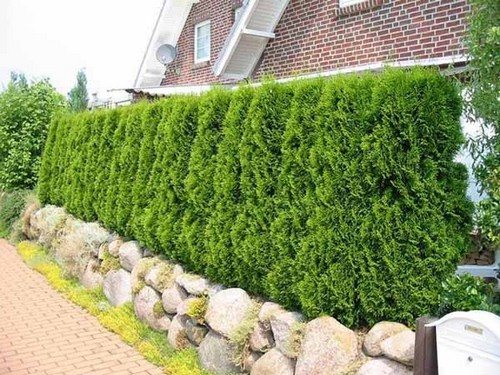
Advantages:
- appearance and the ability to give it almost any shape, change the design and height over time;
- environmental friendliness. Plants will trap dust and noise;
- using thorny plants (for example, hawthorn), you can obtain reliable protection for the site;
- low cost;
- wind resistance and ventilation.
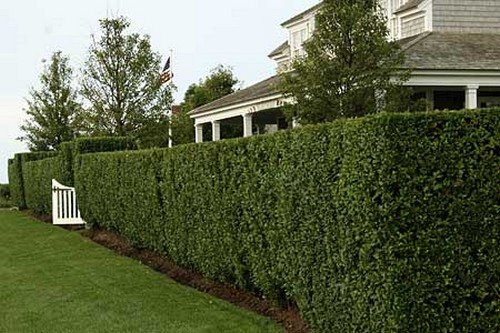
Flaws:
- the need for constant care: watering, fertilizing, cutting, etc.;
- the need to wait until a normal and dense hedge grows;
- You will need good knowledge of horticulture and dendrology, or you will need to contact a specialist.
No. 17. Other interesting materials
The following can be used as fencing:
- slate _ Today, slate is not as popular in the construction of country fences as it was ten years ago, but there are still people who want to build such an inexpensive and functional fence. The advantages of the material are low cost, ease of installation, resistance to weather vagaries and the ability to close the area from the prying eyes of strangers. Cons: poor aesthetics and instability to targeted impacts;
- gabions - blocks of metal mesh and stone;
- wire that is pulled over the supports.
Some craftsmen even manage to use plastic bottles to create a fence.
Place it and you won’t regret it
No one will argue with the fact that the owners of the house themselves are primarily interested in a good, strong and beautiful fence. This is their safety and the opportunity to hide their everyday life from prying eyes. Therefore, most residents treat the requirements of the State Technical Supervision Authority with understanding. They go and clean their fences from years of street dirt and put the fallen bricks back in place. Well, or they find an opportunity to put up a new fence if the old one is completely no good.
In this case, the regional authorities have introduced a new municipal service that allows you to update the fence without lengthy approvals and further work on mistakes. On the regional government services portal, you can issue a fence passport - a document that contains information about the color and material from which the fence is made. To do this, you just need to fill out a special form, indicating the desired parameters of the new fence. The system will analyze the input data and, depending on where the house is located - in a garden community, a cottage community, a village or the private sector of the city, it will provide all possible fencing options in your case, which will definitely not cause any complaints from the supervisory authorities.
To help in the final choice, a portfolio of samples has been developed, which can be found on the website of the regional Ministry of Public Works and in the “Knowledge Base” section on the public services portal. There you can see in pictures what all the fences permitted for installation in the Moscow region look like. There are only 12 of them, but among them there is plastic, metal mesh, and even a vine with a slab. Of course, if your house is located on the first line of urban or rural development, there will be few options, but a fence with a passport will save you from visits from State Technical Supervision inspectors for at least three years. And if you regularly monitor the cleanliness of the fence, it will last forever.
By the way



